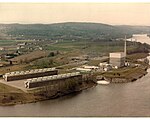Hinsdale Greyhound Park

Hinsdale Greyhound Park was a greyhound racing track in Hinsdale, New Hampshire, United States. It closed in 2008. It was originally Hinsdale Raceway, a horse racing track that began operation in 1958. During its heyday it drew thousands of spectators from all over New England and even Montreal. Harness racing prospered at Hinsdale throughout the 1960s, '70s and early '80s, until track management, in an attempt to reduce costs, converted the facility to year-round greyhound racing. This was popular too for several years, but competition from casinos in neighboring states slowly eroded the fan base, and the last several years of operation were a financial struggle. In late 2008 the track finally succumbed and ceased operations under a mountain of debt. The racetrack was demolished a few years later.
Excerpt from the Wikipedia article Hinsdale Greyhound Park (License: CC BY-SA 3.0, Authors, Images).Hinsdale Greyhound Park
Starting Gate Lane,
Geographical coordinates (GPS) Address Nearby Places Show on map
Geographical coordinates (GPS)
| Latitude | Longitude |
|---|---|
| N 42.810944444444 ° | E -72.528277777778 ° |
Address
Starting Gate Lane
Starting Gate Lane
03451
New Hampshire, United States
Open on Google Maps







